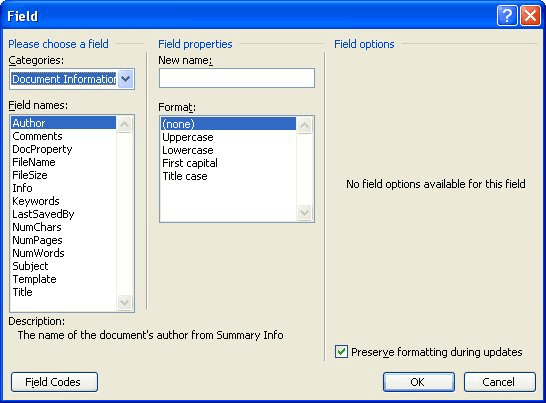Please Note: This article is written for users of the following Microsoft Word versions: 97, 2000, 2002, and 2003. If you are using a later version (Word 2007 or later), this tip may not work for you. For a version of this tip written specifically for later versions of Word, click here: Inserting a Document's Location.
Written by Allen Wyatt (last updated August 12, 2023)
This tip applies to Word 97, 2000, 2002, and 2003
It is often handy to insert the location of a document into your document itself. For instance, you may want the footer of your document to include an indication of a document's file name, along with the full path for the file. You can do this easily by following these steps if you are using Word 2002 or Word 2003:

Figure 1. The Field dialog box.

Figure 2. The Field Specific tab of the Field Options dialog box.
If you are using Word 97 or Word 2000, the steps are slightly different:
WordTips is your source for cost-effective Microsoft Word training. (Microsoft Word is the most popular word processing software in the world.) This tip (1085) applies to Microsoft Word 97, 2000, 2002, and 2003. You can find a version of this tip for the ribbon interface of Word (Word 2007 and later) here: Inserting a Document's Location.

Discover the Power of Microsoft Office This beginner-friendly guide reveals the expert tips and strategies you need to skyrocket your productivity and use Office 365 like a pro. Mastering software like Word, Excel, and PowerPoint is essential to be more efficient and advance your career. Simple lessons guide you through every step, providing the knowledge you need to get started. Check out Microsoft Office 365 For Beginners today!
When you use fields in your document, you may want them to not change from a particular displayed result. You can lock ...
Discover MoreIf you put a field into a text box, you might be surprised to find that it doesn't update when you try to update all your ...
Discover MoreYou can use sequence fields for reliable numbering. They are quick, easy, and don't have some of the drawbacks of ...
Discover MoreFREE SERVICE: Get tips like this every week in WordTips, a free productivity newsletter. Enter your address and click "Subscribe."
There are currently no comments for this tip. (Be the first to leave your comment—just use the simple form above!)
Got a version of Word that uses the menu interface (Word 97, Word 2000, Word 2002, or Word 2003)? This site is for you! If you use a later version of Word, visit our WordTips site focusing on the ribbon interface.
Visit the WordTips channel on YouTube
FREE SERVICE: Get tips like this every week in WordTips, a free productivity newsletter. Enter your address and click "Subscribe."
Copyright © 2025 Sharon Parq Associates, Inc.
Comments